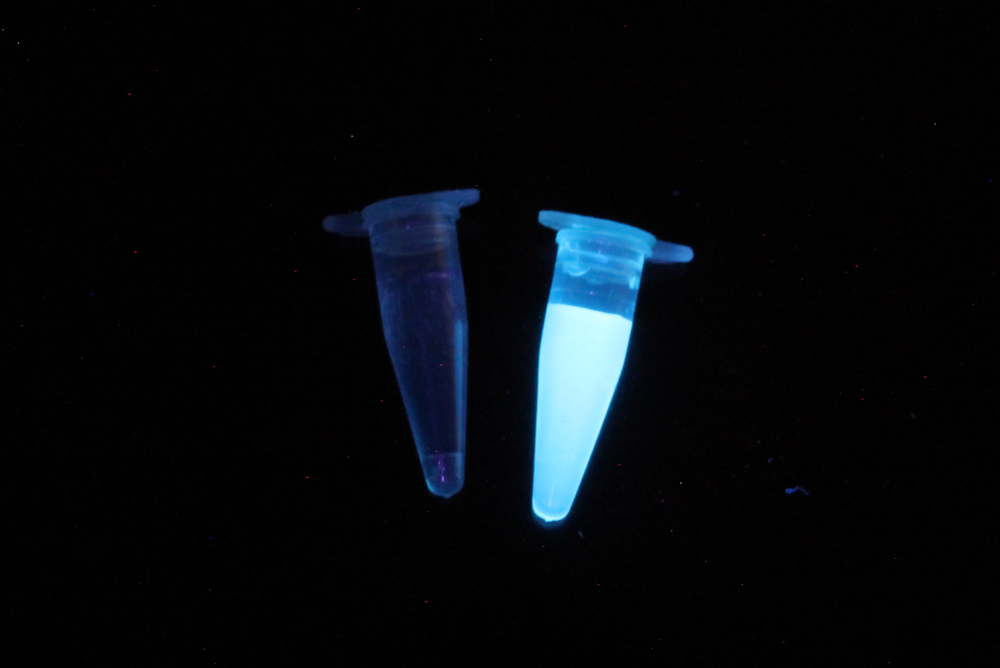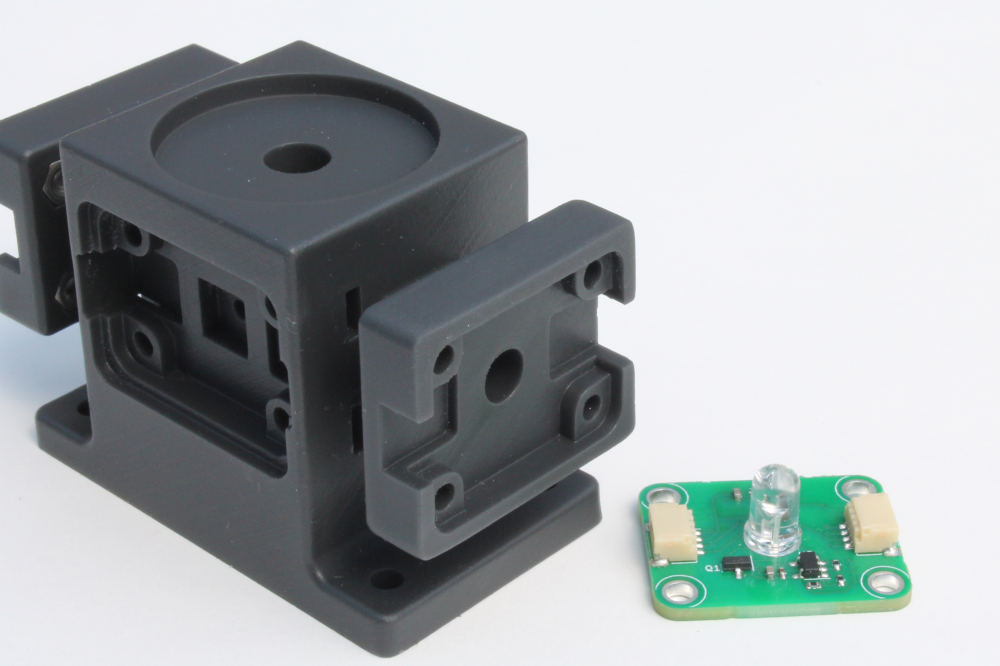Project Update: Open Colorimeter Plus & Fluorescence Measurements
Update to the Open Colorimeter Plus hardware design including new excitation LEDs & testing different emission filters.

We have been developing a version of our Open Colorimeter with a light sensor at 90-degrees in addition to the current 180-degree sensor. The Open Colorimeter Plus dual light-sensors can be used for applications such as fluorescence and light-scattering where measurements are taken at the 90-sensor. This will extend the current absorbance measurements of the Open Colorimeter. An archive of all posts related to this project can be found below:

When we last posted an update on the Open Colorimeter Plus, one of the next goals was to increase the fluorescence signal by making a few design changes. In this post we share some results from these hardware design changes.
New radial LED board design and mount
The main hardware update is the 3D-printed tube or sample holder shown in the images below. For this new design we have moved the LED mount closer to the sample by shortening the length of the two "arms" and most notably switching the excitation LED mount to a radial (through-hole) mount. Both of these changes will bring the light source closer to the sample.


Image of the new sample holder with new LED mount for radial LEDs and shorter distances from the sample. The image on the right also shows the filter holder with a 6mm x 6mm emission filter.
We also designed radial versions of our current-controlled LED boards. Switching to the radial LED boards allows for much greater flexibility when selecting an excitation LED. Below are a couple of radial LED boards which are already in the online store. These LEDs are much brighter than the surface mount Open Colorimeter boards which work well for absorbance measurements. To maximize customization options, we also have a version without any LED mounted (below right image) which can be used for testing different LED options. It works with most 3mm or 5mm through-hole LEDs.



Firmware (in development)
Below is a screenshot of the Open Colorimeter Plus firmware which is currently under development. You can see the values from the two light sensors displayed in this example.
- Sensor 90 = RFU value (Relative Fluorescence Intensity). This is the amount of light intensity at the 90-degree sensor
- Sensor 180 = light measurements at the 180 sensor. This can be useful to compare different LED intensities and can be also used to normalize RFU data between instruments.


Measuring fluorescence using a DNA quantitation assay
We have previously described a DNA quantitation fluorescence assay. We routinely use this test as we are making hardware changes to determine how design changes are impacting fluorescence measurements. Check out the previous post for more details about the assay.

Open Colorimeter Plus Set-Up
- Excitation LED: The new design uses a 470nm radial LED board. We compared this to our previous design which uses the Open Colorimeter surface mount 470nm LED board
- Emission Filter: We tested two filters. A 6 x 6 mm 500nm longpass filter and a 7.5 x 7.5 mm 510nm-580nm bandpass filter (which we had gifted to us from a previous project). The longpass filter is the more affordable option at $45 for a 6 x 6 mm filter, whereas bandpass filters are in the $200 range.

Summary
- As expected, the hardware changes we made to bring the excitation LED closer and switching to using a brighter radial LED increased the fluorescence signal. In this example using the DNA quantitation assay, the new design changes increased fluorescence signal around 16-fold (4056 vs. 252 RFU).

- Using the bandpass filter or longpass filter gave comparable results as shown below. Using the longpass filter resulted in a higher RFU, although background was slightly lower with the bandpass filter. Given the price difference, the longpass filter seems like a good option for this test.

Quinine UV Fluorescence
One other fluorescence test we have recently been experimenting with for the Open Colorimeter Plus is the well-known quinine-UV fluorescence. Quinine is an extract of Cinchona bark, and has been used historically for antimalarial treatment. Quinine excitation by UV light can be easily observed as a glowing blue color with quinine fluorescence in the visible light range at around 450nm. This is easily demonstrated by shining black light on tonic water for example.
Open Colorimeter Plus Set-Up
- Sample: Tonic water
- Excitation: 378nm radial UV LED board


LEFT: Distilled water and tonic water imaged using a UV LED; RIGHT: The same tonic water sample viewed in the Open Colorimeter Plus. The light sensor has been moved aside to photograph fluorescence through the sensor hole
We did a quick comparison of quinine in 3 different tonic brands using the quinine UV-fluorescence and Open Colorimeter Plus. We included East Imperial tonic water as it is reported to have the highest levels of quinine as well as two other brands picked up at the store.
You can see from the data below that we did see the highest levels of quinine in East Imperial tonic water, and varying levels between the different brands. This could be turned into a quantitative method using a quinine standard and calibration curve.

Open Colorimeter Plus: Next (final?) steps
The next steps will be finalizing the Open Colorimeter Plus hardware designs and firmware. Once this is finished we will be adding the Open Colorimeter Plus to our online store along with the 3D-printed cuvette/sample holders and additional radial LED options. Contact us if you have a specific excitation wavelength request! In the meantime, we also have a sign-up form here if you would like to get early notifications on any Open Colorimeter Plus news.
Featured Open Hardware Design: LED storage box
Last week we added a new design for 3D-printing an LED storage box. This was a much-needed item around our workspace, so we wanted to share the open hardware designs with the community.

Link to the 3D-printing files
3D-printing files can be downloaded from the GitHub repository for printing your own storage box. It is also available from our online store in IO Rodeo logo colors.








Comments ()